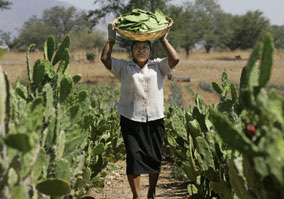 |
 |
 |
 Entertainment | Restaurants & Dining | January 2007 Entertainment | Restaurants & Dining | January 2007  
A Plant That Grows Dreams
 Sam Enriquez - LATimes Sam Enriquez - LATimes


| | Catalina Sanchez carries a basket of nopal cactus from her field, where no pesticides or chemical fertilizers are used. "It grows slower this way and it doesn't look as perfect, but it's healthier," she says. Los Angeles Times photo by Don Bartletti. |
anta Maria Ayoquezco, Mexico - It has taken longer than they expected, but the 170 women who have pooled their savings to launch a bottling plant for nopal cactus here say it's so close that they can almost taste it.

The women had hoped to open the plant in summer, but a five-month siege by striking teachers in Oaxaca, the capital of the state with the same name, slowed the delivery of building materials.

But with order restored, the women say the opening of the plant is just weeks away.

Nopal, the flat, oval-leaf cactus, is a local staple prepared in a variety of recipes, from sweet to savory. And as reported earlier this year in the Los Angeles Times, local people are combining money earned by family members working in the United States with grants from the Mexican government to build the $1.5 million processing plant.

Their plan is to export thousands of jars a week for purchase by Oaxacans and other cactus aficionados living abroad. Their dream is that the enterprise will be successful enough that loved ones will no longer have to travel north of the border to find work.

"After six years of work, I think we're finally there," said Catalina Sanchez, who got the idea after tasting the bottled nopal now sold in California. "We're hoping the factory will open in January."

Oaxacan cactus tastes much better than the California variety, said Sanchez, as she proudly showed off her nopal plot, the size of a football field. Each of the women in the enterprise tends her own plot. The cactus is grown without pesticides or chemical fertilizers.

"It grows slower this way and it doesn't look as perfect, but it's healthier," Sanchez said.

Mild winter weather slows production of the young leaves that are harvested from the tops of the waist-high plants. During the hot spring and summer, Sanchez said, the plants are cut twice a week, with an average yield of 2 pounds per square yard.

While the strike slowed the women down, the number involved in the project increased by several dozen from 134, and the number of investors in a distribution company on the California side also increased.

Nearly 60 Oaxacans in California have invested $100,000 to create a U.S. distribution company that will seek to place jars of the cactus at stores and markets, said Felix Cruz, a San Diego County resident and president of Chapulin Distributors.

Until the Oaxaca factory is up and running, Cruz said, there are no firm commitments to buy the preserved cactus, although many restaurants and stores have expressed interest.

Investors got worried during the five-month conflict that paralyzed Oaxaca's capital city, a 90-minute drive north. A statewide teachers strike that began in May grew into a broad leftist movement calling for the governor's resignation. The protests blocked roads, closed government buildings and scared off tourists.

The federal government intervened in November, chasing off protesters who'd been camping in the central square. The arrest of protest leaders earlier this month took most of the steam out of the movement, and life has largely returned to normal.

For Sanchez and her partners, that means they can put the project back on track now. They are anticipating delivery of specialized machinery from Guadalajara to cut and clean the spiny cactus leaves. They now clean and bottle their samples by hand.

Meantime, workers are installing plumbing fixtures for the 40 people who will be working at the factory when it opens. Floor tiles are being laid in a children's day-care room. Outside, a service road needs to be cleared and paved. Gas lines are unfinished.

During a recent tour, several of the women imagined the factory open and operating. For years, the cactus made them money at the marketplace in Oaxaca City, where they traveled twice a week to sell the fresh leaves. Many made the trip alone, their husbands gone for months or years working in the United States.

"The day the factory opens will be beautiful for everyone," said Lovigilda Perez. "A lot of people are saying that if this is successful, they'll stay here to work. That's our dream."

Cecilia Sanchez of the Times' Mexico City bureau contributed to this report. | 
 | |
 |



